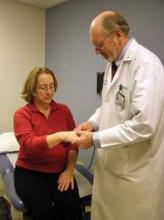Although pregnant with their son, Jon, Dorothy also went to Korea. Conditions were harsh, and the Army made no accommodations for this military wife, even though she came in handy as a pediatrician at the underserved hospital in Seoul. With Robert stationed in "north of the tank wall in a tactical zone at the MASH hospital," he had no car and she could not live on the base there. Instead, she lived in an apartment in Seoul without a car. There was an oil shortage that winter and all water had to be boiled before drinking. Until their son was born, he would visit her in Seoul on weekends when he was free, and she would visit the base on weekends when he was on duty. "The 2½ of us slept in a single bed in a Quonset hut," she recalled in an interview.
The first season of the television show "M*A*S*H" aired the year before Robert arrived in Korea. While he was there, the show’s coproducers visited his MASH unit searching for ideas for the series, which had become wildly popular despite their expectations. "The show was based on a book. They had used up all the material from the book, and they needed fodder for future shows. They did everything we did and interviewed everyone individually. Thus, I can recognize something in every episode beginning in year 3 that was based on our reality. My name was used as a character in one episode [spelled Wortman]. In another episode, they were collecting money for a pool to bet on when Colonel Potter would become a grandfather. At the time of their visit, there was just such a pool at our hospital for when Jon would be born," Robert recalled.
Once Robert was discharged from the U.S. Army, the two doctors moved to Ann Arbor, where Robert was chief resident in internal medicine. Considering how difficult it can be for two physicians to juggle a growing family around their training, the Wortmanns have made it look almost easy. Robert did his rheumatology fellowship from 1977-1979 at Michigan while Dorothy finished her pediatrics residency there, followed by her pediatric rheumatology fellowship at the same institution.
At the time Dorothy was in her fellowship, pediatric rheumatology was not a recognized subspecialty. "I did not do any research, and I was not sure I would be offered academic positions, but I have been fortunate in each of the places we have lived," she noted.
Over the years, the Wortmanns have been at the Medical College of Wisconsin in Milwaukee, where Robert eventually became professor of medicine in the division of rheumatology while Dorothy was on the faculty of the pediatrics department. From there, they moved to East Carolina University, Greenville, where Robert was professor and chairman of the department of medicine. Onward they went to the University of Oklahoma, Tulsa, where Robert was professor and C.S. Lewis Jr. Chair of Internal Medicine. And finally, they went to Dartmouth University, Hanover, N. H., where he is professor of medicine.
His colleague at Dartmouth, Dr. Christopher M. Burns, noted in an interview that: "Bob and Dottie have worked at a number of institutions over the years. Although it’s true that most of their moves were driven by Bob’s career, it’s also true that no matter where she went, Dottie had a big impact. She actually established pediatric rheumatology in Wisconsin, and dramatically improved the pediatric rheumatology programs at all the institutions she’s traveled to with Bob."
Dorothy’s area of particular expertise as a pediatric rheumatologist has been Kawasaki syndrome, a disease she first encountered as a resident: "As senior pediatric residents, we each had to do a Clinical Pathology Conference. Mine was a 3-year-old child who had been admitted for diarrhea and dehydration and who died in the waiting room while waiting for the car to be brought around on discharge. Fortunately, a medical student had taken a very detailed history, and I had read a recent article from Hawaii about a new disease reported in Japan now being seen in Hawaii. That child had Kawasaki syndrome. The cardiac sequelae were just being recognized. As rheumatology fellows at Michigan, we saw these children because it is a vasculitis. When we moved to Milwaukee, there was an outbreak with 20 children in the hospital over a several-week period. In fact, if I remember correctly, there were 13 children in the hospital at one time. This was very unusual. It was reported to the CDC and investigated. I then followed these and subsequent children with one of our cardiologists in a total of about 150 children. This was a large clinical experience at that time and led to those papers."



